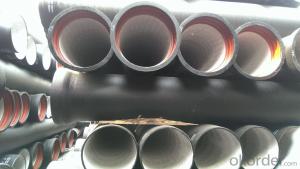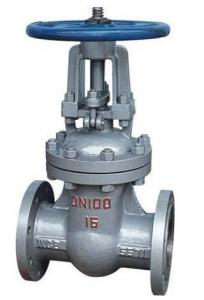DUCTILE IRON PIPE K7 DN 100 SOCKET SPIGOT PIPE
- Loading Port:
- Tianjin
- Payment Terms:
- TT OR LC
- Min Order Qty:
- 25 m.t.
- Supply Capability:
- 30000 m.t./month
OKorder Service Pledge
OKorder Financial Service
You Might Also Like
1) The standard of pipe: ISO2531:1998, EN545:2006,K9 K8
2) Effective length: 6m/5.7m
3) Inner cement line: Portland cement lineas per ISO4179
4) Zinc coating: at least 130g/m2 as per ISO8179
5) Bitumen painting: at least 70μm as per ISO8179
6)With 102% quantity of NBR, SBR, or EPDM ring asper ISO4633
7) DN80-DN1200
8) Highstrength, lighter than grey iron, good corrosion resistance, no furring, smallflow resistance, easy fixing, long life tome about 100 yeas
9)Checked by automatic inspection equipment
10) Composition:
Chemical composition | |||
Chemical composition | Ductile Cast Iron Pipe (%) | Grey iron pipe (%) | Steel pipe (%) |
C | 3.5-4.0 | 3.2-3.8 | 0.1-0.2 |
Si | 1.9-2.6 | 1.4-2.2 | 0.15-0.4 |
Mn | 0.15-0.45 | 0.4-0.6 | 0.3-0.6 |
P | ≤0.06 | ≤0.3 | 0.02-0.03 |
S | ≤0.02 | ≤0.1 | 0.02-0.03 |
Mg | 0.03-0.06 |
|
|
11) Feature:
Mechanical properties | |||
| Ductile Cast Iron Pipe | Grey Iron Pipe | Steel Pipe |
Tensile Strength(Mpa) | ≥420 | 150-260 | ≥400 |
Yield Strength(Mpa) | ≥300 | No Confirmation | No Confirmation |
Bending Strength(Mpa) | ≥590 | 200-360 | ≥400 |
Elongation (%) | ≥10 | Neglected | ≥18 |
Brinell Hardness(HBS) | ≤230 | ≤230 | About 140 |
12) T type mechanical joint
13) Packing: in bulk or container
PACKING: 1) Pipesare bundled together with the steel belt.
2) Wooden pieces are put between the pipes.
- Q:Is there any cast iron pipe used in the fire hose?
- No, I think so. In theory, you can.See if the specifications have any requirements for the material.
- Q:How are ductile iron pipes protected against interior corrosion?
- Cement mortar lining is utilized to protect ductile iron pipes against interior corrosion. This process involves the application of a layer of cement mortar to the inner surface of the pipe. By acting as a protective barrier, the cement mortar prevents the corrosive elements in the water or fluid from directly contacting the iron material. To apply the cement mortar lining, the interior surface of the ductile iron pipe is initially prepared by removing any loose scale or debris. Next, a mixture of cement, sand, and water is prepared to create a paste-like consistency. Skilled workers can then manually apply this mixture to the interior surface of the pipe or use a spinning machine. Once the cement mortar lining is applied, it must cure for a specific period, typically around 24 hours. During this curing process, the cement mortar hardens and forms a dense protective layer on the pipe's inner surface. The cement mortar lining provides several advantages in safeguarding ductile iron pipes against corrosion. It creates a smooth and continuous surface that prevents direct contact between the water or fluid and the iron material, thus reducing the risk of corrosion. Additionally, the lining helps to minimize friction within the pipe, thereby enhancing flow efficiency. It is crucial to regularly inspect and maintain the cement mortar lining to ensure its effectiveness in preventing corrosion. Over time, the lining may develop cracks or deteriorate, compromising its protective properties. Therefore, periodic inspections are necessary to repair or replace the lining as required, ensuring the integrity of the ductile iron pipes and preventing interior corrosion.
- Q:Can ductile iron pipe be used for geothermal heat exchange systems?
- Yes, ductile iron pipe can be used for geothermal heat exchange systems. Ductile iron pipe is known for its strength and durability, which makes it suitable for handling the high temperatures and pressures associated with geothermal heat exchange systems. Additionally, ductile iron pipe has excellent corrosion resistance, which is important in geothermal systems where minerals and chemicals in the ground can cause corrosion. Ductile iron pipe also has good thermal conductivity, allowing for efficient heat transfer in geothermal systems. Overall, ductile iron pipe is a reliable and cost-effective choice for geothermal heat exchange systems.
- Q:Do ductile iron pipes require internal linings for potable water?
- No, ductile iron pipes do not require internal linings for potable water. Ductile iron is a type of iron that has been treated to enhance its strength and flexibility. It is commonly used for water distribution systems due to its durability and resistance to corrosion. Unlike other materials, such as cast iron or steel, ductile iron pipes have a protective layer called a cement-mortar lining, which provides an effective barrier against corrosion and prevents the leaching of any harmful substances into the water. This lining is applied during the manufacturing process and is designed to withstand the corrosive properties of potable water, making internal linings unnecessary. Additionally, the smooth surface of ductile iron pipes helps to maintain the quality and flow of water without the need for additional linings.
- Q:Can ductile iron pipe be used for power plant cooling water systems?
- Yes, ductile iron pipe can be used for power plant cooling water systems. Ductile iron pipe is known for its high strength and durability, which makes it suitable for various applications, including cooling water systems in power plants. It has excellent corrosion resistance, making it resistant to the corrosive effects of water and chemicals commonly found in cooling water systems. Additionally, ductile iron pipe has a smooth interior surface that minimizes friction loss and allows for efficient water flow. These characteristics make ductile iron pipe a reliable and cost-effective choice for power plant cooling water systems.
- Q:How do ductile iron pipes handle differential settlement?
- Ductile iron pipes possess exceptional durability and are renowned for their ability to endure diverse environmental conditions, including differential settlement. Differential settlement refers to the uneven settling of the ground, which can often impose stress and strain on underground pipes. Specifically engineered to address settlement issues, ductile iron pipes exhibit inherent flexibility and strength. These pipes possess the capacity to flex and accommodate slight ground movements without incurring significant damage or failure. The flexibility of ductile iron pipes enables them to evenly distribute the stress and strain caused by differential settlement along their length. This characteristic assists in averting concentrated stress points that could potentially result in cracks or fractures in the pipe. Furthermore, the inherent strength of ductile iron pipes equips them with the necessary resistance to withstand the forces generated by differential settlement. The pipes' robust construction and high tensile strength render them less susceptible to deformation or damage caused by ground movements. Moreover, ductile iron pipes are commonly installed with flexible joints, such as rubber gaskets or push-on joints. These joints permit some movement and adapt to any slight misalignment or settlement that may occur. By providing flexibility at the joints, the pipes can better adjust to changes in ground conditions and diminish the risk of failure. In conclusion, ductile iron pipes possess the necessary attributes to effectively cope with differential settlement due to their flexibility, strength, and utilization of flexible joints. These features guarantee that the pipes can endure ground movements and continue to function efficiently without compromising their integrity or longevity.
- Q:What is the expected joint deflection of ductile iron pipes?
- The expected joint deflection of ductile iron pipes depends on various factors such as the diameter of the pipe, the type of joint used, and the specific conditions of the installation. In general, ductile iron pipes are designed to accommodate some degree of deflection at the joints to allow for flexibility and movement. The American Water Works Association (AWWA) provides guidelines for the maximum allowable joint deflection for ductile iron pipes. According to AWWA C151/A21.51, the maximum deflection at the joint should typically not exceed 3 degrees or 1% of the nominal pipe diameter, whichever is greater. It is important to note that joint deflection should be within the specified limits to ensure the structural integrity and performance of the pipeline system. Excessive joint deflection can lead to leaks, failures, and reduced lifespan of the pipes. To determine the exact expected joint deflection for a specific installation, it is best to refer to the manufacturer's specifications and guidelines, as they may vary depending on the pipe size, joint type, and other factors. Consulting with a qualified engineer or contacting the manufacturer directly can provide more accurate information tailored to the specific project requirements.
- Q:Ductile iron pipes perennial bubbles in the water will rot it
- Water supply pipe is the first choice, with high cost performance. Compared with the PE pipe, from the installation time, ductile pipe PE pipe installation is simple and rapid, and after the installation of internal and external pressure bearing better tightness and corrosion resistance; from the point of view, ductile pipe sealing better after installation, but also can improve the corrosion resistance through various anti-corrosion methods;
- Q:Can ductile iron pipe be used for industrial process piping?
- Indeed, industrial process piping can make use of ductile iron pipe. Renowned for its robustness, longevity, and ability to withstand corrosion, ductile iron pipe proves itself as an appropriate selection for diverse industrial functions. It boasts the capability to manage high-pressure systems and commonly finds application in sectors like water and wastewater treatment, oil and gas, chemical processing, and power generation. Moreover, ductile iron pipe offers ease of installation and an extensive lifespan, thus rendering it a cost-efficient choice for industrial process piping.
- Q:What are the different types of fittings available for ductile iron pipe?
- There are several types of fittings available for ductile iron pipe, including elbow fittings, tee fittings, cross fittings, reducer fittings, flanged fittings, and mechanical joint fittings. These fittings are designed to connect and redirect the flow of the pipe, ensuring a secure and efficient system.
1. Manufacturer Overview |
|
|---|---|
| Location | |
| Year Established | |
| Annual Output Value | |
| Main Markets | |
| Company Certifications | |
2. Manufacturer Certificates |
|
|---|---|
| a) Certification Name | |
| Range | |
| Reference | |
| Validity Period | |
3. Manufacturer Capability |
|
|---|---|
| a)Trade Capacity | |
| Nearest Port | |
| Export Percentage | |
| No.of Employees in Trade Department | |
| Language Spoken: | |
| b)Factory Information | |
| Factory Size: | |
| No. of Production Lines | |
| Contract Manufacturing | |
| Product Price Range | |
Send your message to us
DUCTILE IRON PIPE K7 DN 100 SOCKET SPIGOT PIPE
- Loading Port:
- Tianjin
- Payment Terms:
- TT OR LC
- Min Order Qty:
- 25 m.t.
- Supply Capability:
- 30000 m.t./month
OKorder Service Pledge
OKorder Financial Service
Similar products
New products
Hot products
Related keywords


























